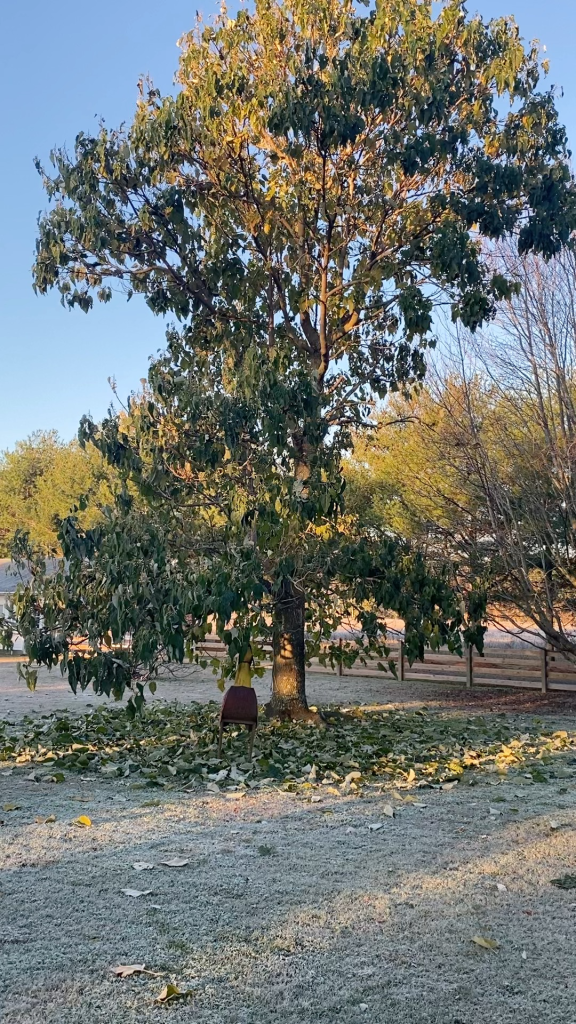My Paulownia Tree
Thank you, Wiki, to whom I contribute to, for my lead-in for this Blog.
Paulownia (/pɔːˈloʊniə/ paw-LOH-nee-ə) is a genus of seven to 17 species of hardwood tree (depending on taxonomic authority) in the family Paulowniaceae, the order Lamiales. They are present in much of China, south to northern Laos and Vietnam and are long cultivated elsewhere in eastern Asia, notably in Japan and Korea.
It was introduced to North America in 1844 from Europe and Asia where it was originally sought after as an exotic ornamental tree. Its fruits (botanically capsules) were also used as packaging material for goods shipped from East Asia to North America, leading to Paulownia groves where they were dumped near major ports. The tree has not persisted prominently in US gardens, in part due to its overwintering brown fruits that some consider ugly.[1] In some areas it has escaped cultivation and is found in disturbed plots. Some US authorities consider the genus an invasive species,[2] but in Europe, where it is also grown in gardens, it is not regarded as invasive.
The genus, originally Pavlovnia but now usually spelled Paulownia, was named in honour of Anna Paulowna, queen consort of The Netherlands (1795–1865), daughter of Tsar Paul I of Russia. It is also called “princess tree” for the same reason.[3]
Paulownia trees produce as many as 20 million tiny seeds per year. However, the seeds are very susceptible to soil biota and only colonize well on sterile soils (such as after a high temperature wildfire). Well-drained soil is also essential. Successful plantations usually purchase plants that have been professionally propagated from root cuttings or seedlings.[4] Although seeds, seedlings, and roots of even mature trees are susceptible to rot, the wood is not and is used for boat building and surfboards.
Trees can grow to maturity in under 10 years and produce strong, lightweight timber, good as firewood, with an even higher strength to weight ratio than balsa wood.[5] Its density is low at around 0.28 kg/liter,[6][5][7] although significantly higher than balsa’s very low 0.16 kg/liter.[8][9]
My Paulownia tree was planted about fifteen years ago from seed. The tree appeared to die off that first year, and when I did the first mowing, what little I had left, I mowed over it. Throughout the mowing season, if there was any growth, it was cut. After that first year, it grew with a vengeance, underground, it must have been doing things I was unaware of. The tree has been growing ever since.
We had one winter back some years ago with a lot of ice. If you can pick out the difference of the right side of the tree, that side faces North. Several limbs broke off that year, and it remains vacant today.
Today, 18 November 2022, was our first frost. The temperature dropped to 28f, and the Princess started dropping her leaves. Historically the tree drops her leaves beginning on the first frost. After conferring with Mrs., we both believe this is our latest first frost here on Marylands Eastern Shore.
I’m guessing Al Gore would say Global Wahttps://www.conserve-energy-future.com/al-gore-and-global-warming.phprming.

History of Paulownia
The below information is from the site – https://paulowniatrees.org/about/about-the-paulownia-tree/
Paulownia wood has been used in Japan for centuries primarily as a furniture wood. Wooden chests of drawers called Tansu are made from this wood and nearly every Japanese home has a Tansu of solid Paulownia, or sliced Paulownia veneer glued on a Lauan plywood. Other uses of the wood include musical instruments called Koto, wooden clogs called Geta, ornamental carvings, wooden bowls and spoons, bas relief panels, and large and small gift boxes. While the Japanese do not consider this tree “Holy”, the wood is held in reverence by those who work with the tree, possibly due to the ability of the tree to regenerate from its own root. This, coupled with its resistance to rot and its freedom from checking and cracking, may account for this reverence.
Properties of Paulownia
Paulownia is 30% lighter than any comparable American hardwood, falling mid-way between balsa and poplar. The wood weighs between 15 and 19 pounds per cubic foot air-dried. The tree will not rot when felled in the forest unless it is touching a contaminant of some sort. The lumber can be air dried in as little as 60 days in racks or kiln dried to 10% – 12% moisture in five to seven days.
Uses
Logs may be debarked, milled into lumber, exported, or used in established domestic markets. U.S.-based markets are being developed continuously and account for over 80% of all timber harvested domestically. Water and snow sports products make up much of the current usage, and marine-grade plywood production efforts are well underway.
Across the Bay
There are three women from around here that do a Whale of a good thing together. For at least the past three years these ladies have ventured out on the SEA, we call it the Atlantic Ocean around here. So far it has been via the Tidewater area of Virginia. To get there from here you head south and cross the lower Chesapeake Bay where it meets the Atlantic Ocean via the Chesapeake Bay Bridge Tunnel. This year the trio will take the Cape May – Lewes Ferry, crossing Delaware Bay. And what is this you ask, it’s a Whale watching adventure, on a boat.
The girls, Mary Agnes, Kathryn, and Alexis do a lot of things together. Mary Agnes is the Matriarch, Kathryn is her daughter, and Alexis might as well be a daughter. There is a definite Irish connection there. We shall save that connection for another time down the road. These girls also spend a lot of time together wearing out the soles of sneakers. Marathons, half marathons, 10-Ks, 5-Ks and lazy meanderings are often the order of a day off together.
Previously the girls used Virginia Beach, VA as their launch site. This year they shall venture out from Cape May. They will spend their nights in Wildwood Crest, just north of Cape May. New places to shop, new restaurants to try out. Perhaps they could work their way north in the coming years and travel further up the east coast. There great shopping and food venues in places like Montauk, Long Island, Newport, Rhode Island, and Gloucester, Massachusetts. I’m told they even see Whales way up there in Canada.
What a difference a day makes. Yesterday we had temperatures in the low to mid 70’s here on the East Coast of the USA. It is now Sunday 13 November 2022 and as I type this at 0630 hrs. it is 49f, 9.4c for the rest of the world. Will we ever change and join the world community? But then again, the English still weigh in Stones. I guess we all have our little quirks.
11/13/2022 Today’s Marine Forcast…Nw Winds Around 20 Kt With Gusts Up To 30 Kt. Seas 3 To 5 Ft. Nw Swell 3 To 5 Ft At 4 Seconds. Light Swells. Showers Likely Early This Morning, Then A Chance Of Showers Late This Morning. A small craft warning is in effect. Will the girls get a rain check once again? Thank the good Lord shopping is always an option.
November 10, 2022
A Birthday
Yes today is my birthday, along with every other present and past United States Marine. No matter where we born, Parris Island, SC, San Diego CA or Quantico, VA. When you get that Eagle Globe and Anchor, your life as a Marine has begun. I feel I’m looking pretty good for a man of 247 years.
Here is the Commandant’s message for this the 247 Birthday of the Marine Corps. Should you be interested in learning a little more, take a few minutes and watch the accompanying video.
The US Marine Corps started as the Continental Marines on November 10, 1775. On that date, the Second Continental Congress decided that they needed 2 battalions of Marines to serve as landing forces with the Continental Navy during the American Revolutionary War (1775–1783).
(Photo from : https://weaponsandwarfare.com/about/
After the war, the Continental Navy was dismantled, and as a consequence the Marines as well. However, after increasing conflict with revolutionary France, the Marine Corps was formally re-established.
Trainning
If you live east of the Mississippi river, your boot camp training will be located at Parris Island, SC. Now there is a special place that brings back many memories from every Marine who has gone through that training.
Parris Island has a long history of colonization. Many attempts were made at permanent settlement between 1526 and 1722. The first successful attempt was made by the French in 1562, followed by the Spanish and finally the British. After the Revolutionary War, Parris Island plantations began to grow cotton instead of indigo. During the Civil War, the island became a coaling station for the Union Navy.
Nov. 2, 1861 – The first Marines in the area of Parris Island sailed into Port Royal Harbor, S.C., as members of detachments aboard various ships with the Atlantic Blockading Squadron. Commanding officer, Navy Capt. Samuel F. Du Pont, seized the area and it was used as an important base for the Union Navy throughout the Civil War.
Aug. 7, 1882 – An act of Congress authorized the establishment and construction of a coaling dock and naval storehouse at Port Royal Harbor. A select group of naval officers chose Parris Island as the site.
Yamassee
In early July of 1962 this writer arrived at Parris Island via Yamassee, SC.
Although Parris Island’s first recruits arrived on the USS Prairie in October 1915, the Marines developed that same year a train station at Yemassee, S.C., which was the depot’s initial receiving point for the central and eastern recruiting stations. The town then had a bank, a general store, a few houses and “an abundancy of South Carolina pine.” A hotel was also there in 1915, and the Marines praised its ballroom and the gracious hospitality of the townspeople, especially its pretty girls. Recruits arriving at Yemassee on the Atlantic Coast Line Railroad would be transferred to the Charleston & Western Railroad, which ran to Port Royal. Once there, the World War I recruits would be placed on everything from side wheel ferryboats, barges, long boats or a kicker (a small motor boat) for the trip to Parris Island. Today, most all recruits are flown to this great advenure and will land in Charleston, SC.
I along with a host of new recruits from more northern states would board a train at 30th street station in Philadelphia, PA and head south to 13 weeks of summer camp. Should wish to learn more of this summer adventure check out https://www.mcrdpi.marines.mil/Centennial-Celebration/Historical-information/8-Yemassee-SC/
Marine Corps Recruit Depot San Diego
Today this Recruit Depot provides its nation’s Corps with basically trained Marines to fight in the current conflicts in both Iraq and Afghanistan. The depot has the responsibility to train all male recruits who reside west of the Mississippi River to serve at the call of the nation. Some history should you be interested. https://www.mcrdsd.marines.mil/About/Depot-History/
Officer Candidates School
The mission of Officer Candidates School (OCS) is to educate and train officer candidates in Marine Corps knowledge and skills within a controlled and challenging environment in order to evaluate and screen individuals for the leadership, moral, mental, and physical qualities required for commissioning as a Marine Corps officer.















